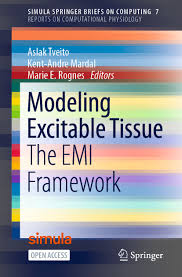
| Judul | Modeling Excitable Tissue : The EMI Framework / Edited by : Tveito, Aslak; Mardal, Kent-Andre ;Rognes, Marie E. |
| Pengarang | Aslak, Tveito Kent-Andre, Mardal Marie E. , Rognes |
| EDISI | - |
| Penerbitan | Springer Nature, 2021 |
| Deskripsi Fisik | 116 p. :ill. |
| ISBN | 978-3-030-61157-6 |
| Subjek | MATHEMATICAL AND COMPUTATIONAL BIOLOGY |
| Catatan | This open access volume presents a novel computational framework for understanding how collections of excitable cells work. The key approach in the text is to model excitable tissue by representing the individual cells constituting the tissue. This is in stark contrast to the common approach where homogenization is used to develop models where the cells are not explicitly present. The approach allows for very detailed analysis of small collections of excitable cells, but computational challenges limit the applicability in the presence of large collections of cells. |
| Bentuk Karya | Tidak ada kode yang sesuai |
| Target Pembaca | Tidak ada kode yang sesuai |
| Lokasi Akses Online |
https://oer.unair.ac.id/files/original/52a7f64132bd381a91d8af7cb11ef4ac.pdf |
| No Barcode | No. Panggil | Akses | Lokasi | Ketersediaan |
|---|---|---|---|---|
| 080925192 | 518 Mod | Baca di tempat | Perpustakaan Pusat - Online Resources Ebook |
Tersedia |
| Tag | Ind1 | Ind2 | Isi |
| 001 | INLIS000000000160246 | ||
| 005 | 20250409023642 | ||
| 007 | ta | ||
| 008 | 250409################|##########|#|## | ||
| 020 | # | # | $a 978-3-030-61157-6 |
| 035 | # | # | $a 0010-0425000178 |
| 082 | # | # | $a 518 |
| 084 | # | # | $a 518 Mod |
| 245 | # | # | $a Modeling Excitable Tissue : $b The EMI Framework /$c Edited by : Tveito, Aslak; Mardal, Kent-Andre ;Rognes, Marie E. |
| 250 | # | # | $a - |
| 260 | # | # | :$b Springer Nature,$c 2021 |
| 300 | # | # | $a 116 p. : $b ill. |
| 505 | # | # | $a This open access volume presents a novel computational framework for understanding how collections of excitable cells work. The key approach in the text is to model excitable tissue by representing the individual cells constituting the tissue. This is in stark contrast to the common approach where homogenization is used to develop models where the cells are not explicitly present. The approach allows for very detailed analysis of small collections of excitable cells, but computational challenges limit the applicability in the presence of large collections of cells. |
| 650 | # | # | $a MATHEMATICAL AND COMPUTATIONAL BIOLOGY |
| 700 | 1 | # | $a Aslak, Tveito |
| 700 | 1 | # | $a Kent-Andre, Mardal |
| 700 | 1 | # | $a Marie E. , Rognes |
| 856 | # | # | $a https://oer.unair.ac.id/files/original/52a7f64132bd381a91d8af7cb11ef4ac.pdf |
| 990 | # | # | $a 080925192 |
Content Unduh katalog
Karya Terkait :